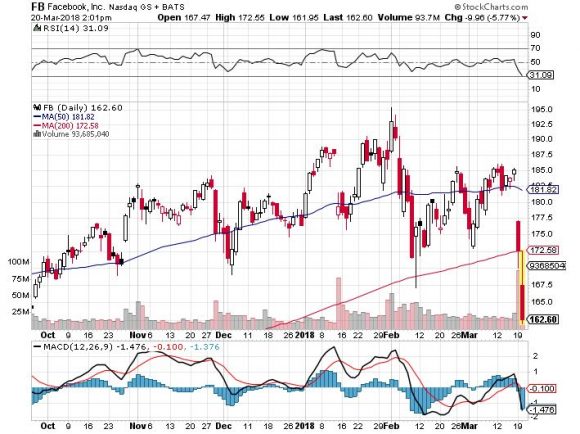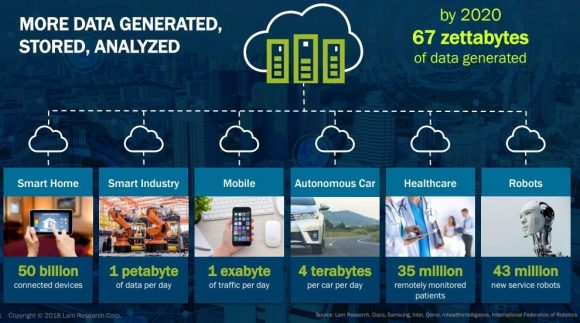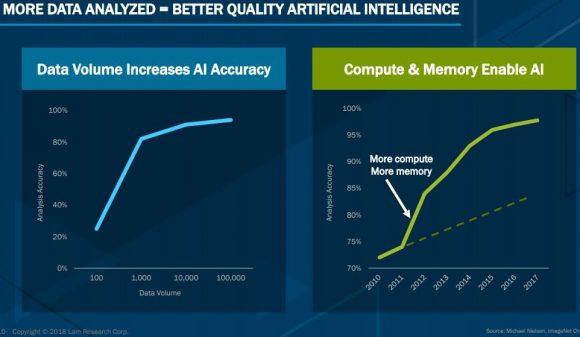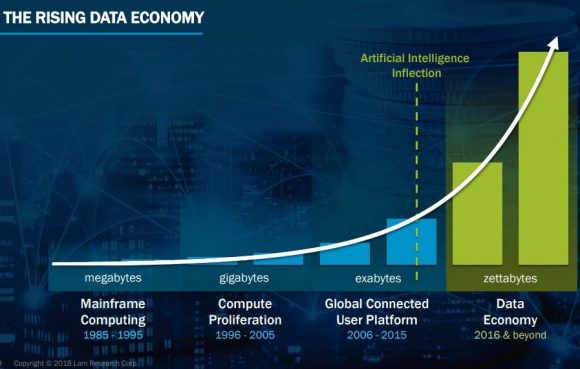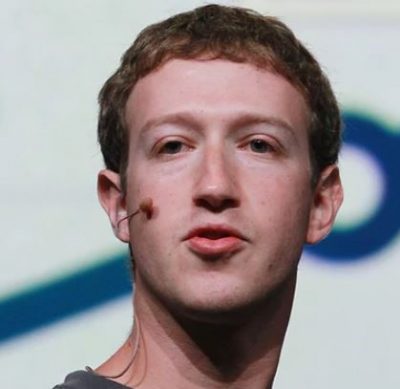Mad Hedge Technology Letter
March 26, 2018
Fiat Lux
Featured Trade:
(MICRON TECHNOLOGY KNOCKS THE COVER OFF THE BALL)
(MU), (WDC)
Micron (MU) was my inaugural stock pick for the first issue of the Mad Hedge Technology Letter on February 1, 2018, and it's time to check this neck of the woods after yesterday's earnings call.
Since I urged readers to jump into this stock at $40, it has skyrocketed to an intraday high of $61.85.
Not bad for a seven-week return.
A bet on Micron is a bet on its visionary leader, Micron CEO and UC Berkeley graduate, Sanjay Mehrotra, who has the propensity to be brilliant.
Mehrotra individually holds 70 chip patents.
He initially was credited for driving outperformance as SanDisk's CEO until Western Digital (WDC) acquired SanDisk in 2016.
Mehrotra has worked at every point on the supply line and knows the industry inside out. He is a pathfinder in a sea of cutthroat competition, and I drop everything to listen to his earnings call. You should do the same.
Rattling off numbers will not do justice to the brilliance of Micron. The great metrics are endless not to mention EPS growth up 15% QOQ, and up over 200% YOY. Cash flow generated from operations was $4.3 billion representing 59% of revenue, which compares to $1.8 billion a year earlier.
Almost every number outperforms sequentially with raised guidance.
The key takeaways were SSD (Solid State Drive) sales up 80% YOY, and the sale of cloud and enterprise solutions more than tripled YOY. Particularly, DRAM chips are Micron's bread and butter, and the DRAM market is suffering from tight supply.
DRAM comprised 71% of total quarterly revenue, and DRAM revenue was up 14% QOQ and 76% YOY.
Shipment volume rose while ASPs (Average Selling Price) increased in the low double-digits. DRAM gross margin was 66% in the quarter and up 22% YOY.
Roaring demand for DRAM and NAND products ushered in record quarterly revenues for the automotive market segment. Strong numbers came from ADAS (Advanced Drive Assistance Systems) and in-vehicle experience applications.
An expanding smorgasbord of DRAM and NAND solutions mean Micron is well-positioned to continue to captain the ship in this rapidly growing market.
A surge in the percolating industrial IoT (Internet of Things) market, expanding factory automation, and surveillance applications mesh nicely with Micron's product offerings.
The newest standards in mobile, automotive devices require rapid data analysis in storage, enterprise and cloud servers, including machine learning, training and inferencing to supplement the computing taking place at the edge.
Automotive clients will thrive from Micron's highest speed LPDDR4 (Low Power Double Data Rate Memory) solutions and other upcoming memory technologies such as the high-bandwidth GDDR6 graphics memory.
The fostering of AI materializes in AI smart cockpits in new automotive models. The instrument dashboard integrates with infotainment and telematics systems with a centralized computer and storage architecture to create a data center on wheels.
Voice and gesture recognition mixed with driver alert monitoring capabilities forge more intelligent and computer intensive automobiles requiring more powerful memory and higher capacity.
Micron has plowed significant investments into the data center to jack up memory and high-performance storage. An important sign is Micron's embedment into the heart of smart car development.
Smartphone makers paraded around high-end smartphones with bigger 4K displays, multiple high-resolution cameras, and 4K HDR video recording at the Mobile World Congress.
Capacity for SSDs are rising in new flagship models using 64GB of flash memory at a minimum. Micron's NAND solution is tailor-made to meet the demand, and Micron is best of breed in TLC (Thin Layer Chromatography) utilization.
Consumers will see a new emphasis on the implementation of A.I. and A.R. into new phones by OEMs (Original Equipment Manufacturer).
It soon will be standard to include facial and voice recognition, real-time translation, fast image search, and scene detection. This is the next gap up for smartphones.
Micron is perfectly positioned for the onslaught of fresh data the world will grapple with soon. High-end smartphones are traversing toward 6GB of LPDRAM, boding well for Micron considering Micron's preeminence in LPDRAM.
The hallmark of this technology is power efficiency essential for optimizing battery life. The LPDDR4's goal is to double data rates (up to 3200 Mb/s) over last generation RAM. Faster memory speeds will support the new migration toward this progression.
Capital investments of $7.5 billion will sustain Micron's leadership status, and Micron targets R&D at 30% to total revenue. Cost will incur transforming to high-value solutions and accelerate with revenue. Steps have been put in place to begin execution of funding the development of the fourth generation of 3D NAND technology.
Micron is in the midst of improving its R&D facilities to accommodate the future of 3D NAND nodes. The trend of higher R&D costs is universal in the semiconductor area as optimal bit growth makes a huge difference in how products are formulated.
The only hiccup in an extraordinary quarter was a maintenance issue at a Taiwan DRAM fab plant, reducing production and dragging down revenue for next quarter by 2%.
However, if you stand back a few feet, Micron's results were nothing short of spectacular. Mehrotra's way of laying out the awe-inspiring future, and Micron's ability to cross-intersect with almost every major secular trend especially pinpoint attention to automotive vehicles is genius.
Micron sold off hard on the earnings and was down more than 8% aftermarket, but this is certainly a case of rising too far too fast mixed with the broad-based China tariff sell-off.
This stock is a tap in to pierce the $100 mark and is pivotal to the future of American technology. It should be at the vanguard of any serious portfolio, and a slew of Micron Trade Alerts is waiting in the pipeline.
The fascinating thing here is that the dynamics of the chip industry are totally changing. It used to be highly cyclical and volatile. But chips are becoming so endemic to the modern economy that they are stabilizing the industry on a long-term basis.
These earnings are no flash in the pan, no one-hit wonder.
Load up on Micron shares on any serious dip.
__________________________________________________________________________________________________
Quote of the Day
"Two years from now, spam will be solved." - said Bill Gates, founder of Microsoft, at the World Economic Forum in 2004
Mad Hedge Technology Letter
March 23, 2018
Fiat Lux
Featured Trade:
(HOW ENVIRONMENTALISTS MAY KILL OFF BITCOIN)
(BTC), (ETH), (TWTR), (SQ)
If Jack Dorsey's proclamation that bitcoin will be anointed the global "single currency," it could spawn a crescendo of pollution the world has never seen before.
In a candid interview with The Times of London, Dorsey, the workaholic CEO of Twitter (TWTR) and Square (SQ), offered a 10-year time horizon for his claim to come to fruition.
The originators of cryptocurrency derive from a Robin Hood-type mentality circumnavigating the costly fees and control associated with banks and central governments.
Unfolding before our eyes is a potential catastrophe that knows no limits.
Carbon emissions are on track to cut short 153 million lives as environmental issues start to spin out of control while the world's population explodes to 9.7 billion in 2050, from 8.5 billion people in 2030, up from the 7.3 billion today. All these people will need to barter in bitcoin, according to Jack Dorsey.
Cryptocurrency is demoralizingly energy intensive, and the recent institutional participation in crypto server farms will exacerbate the environmental knock on effects by displacing communities, destroying wildlife, and climate-changing carbon emissions.
This seemingly controversial means to outmaneuver the modern financial system has transformed into a murky arms race among greedy crypto currency miners to use the cheapest energy sources and the most efficient equipment in a no-holds-barred money grab.
Bitcoin and Ethereum mining combined energy consumption would place them as the 38th-largest energy consuming country in the world - if they were a country - one place ahead of Austria.
Mining a bitcoin adjacent to a hydropower dam is not a coincidence. In fact, these locales are ground zero for the mining movement. The common denominator is the access to cheap energy usually five times cheaper than standard prices.
Big institutions that mine cryptocurrency install thousands of machines packed like a can of sardines into cavernous warehouses.
In 2015, a documentary detailed a large-scale foreign mining operation with an electricity outlay of $100,000 per month to create 4,000 bitcoins. These are popping up all over the world.
An additional white paper from a Cambridge University study uncovered that 58% of bitcoin mining comes from China.
Cheap power equals dirty power. Chinese mining outfits have bet the ranch on low-cost coal and hydroelectric generators. The carbon footprint measured at one mine per day emitted carbon dioxide at the same rate as five Boeing 747 planes.
The Chinese mining ban in January set off a domino effect with the Chinese mining operations relocating to mainly Canada, Iceland, and the United States. Effectively, China has just exported a tidal wave of new pollution and carbon emissions.
Bitcoin is mined every second of every day and currently has a supply of from approximately 17 million today, up from 11 million in 2013. Bitcoin's electricity consumption has been elevated compared to alternative digital payment currencies because the dollar price of bitcoin is directly proportional to the amount of electricity that can profitably be used to mine it.
To add more granularity, miners buy more servers to maintain profitability then upgrade to more powerful servers. However, the new calculating power simply boosted the solution complexity even faster. The mine was practically outdated upon launch, and profitability could only occur by massively scaling up.
Consumer grade personal computers are useless now because the math problems are so advanced and complicated.
Specialized hardware called Application-Specific Integrated Circuit (ASIC) is required. These mining machines are massive, hot, and guzzle electricity.
Bitcoin disciples would counter, describing the finite number of bitcoins - 21 million. This was part of the groundwork laid down by Satoshi Nakamoto (a pseudonym), the anonymous creator of bitcoin, when he (or they) constructed the digital form of money.
Nakamoto could not have predicted his digital experiment backfiring in his face.
The bottom line is most people use bitcoins to literally create money out of thin air in digital form, rather than using it as a monetary instrument to purchase a good or service. That is why people mine cryptocurrency, period.
Now, excuse me while I go into the weeds for a moment.
Enter hard fork.
A finite 21 million coins is a misnomer.
A hard fork is a way for developers to alter bitcoin's software code. Once bitcoin reaches a certain block height, miners switch from bitcoin's core software to the fork's version. Miners begin mining the new currency's blocks after the bifurcation, creating a new chain entirely and a brand spanking new currency.
Theoretically, bitcoin could hard fork into infinite new machinations, and that is exactly what is happening.
Bitcoin Cash was the inaugural hard fork derived from the bitcoin's blockchain, followed by Bitcoin Gold and Bitcoin Diamond.
Recently, the market of hard fork derivations include Super Bitcoin, Lightning Bitcoin, Bitcoin God, Bitcoin Uranium, Bitcoin Cash Plus, Bitcoin Silver, and Bitcoin Atom. All will be mined.
The hard fork phenomenon could generate millions of upstart cryptocurrency server farms universally planning to infuse market share because new currencies will be forced to build up a fresh supply of coins.
If Peter Theil's prognostication of a 20% to 50% chance of bitcoin's price rising in the future is true, it could set off a cryptocurrency server farm mania. By the way, Theil also believes that there is a 30% chance that Bitcoin could go to zero.
A surge in price of bitcoin results in mining cryptocurrency operations everywhere by any type of electricity, especially if the surge maintains price stability. Even mining in Denmark, where one finds the world's costliest electricity at $14,275 per bitcoin, would make sense.
Recently, miners' appetite for power is causing local governments to implement surcharges for extra infrastructure and moratoriums on new mines. Even these mines built adjacent to hydro projects are crimping the supply lines, and consumers are forced to buy power from outside suppliers. Miners are often required to pay their utility bills months in advance.
By July 2019, mining will possibly need more electricity than the entire United States consumes. And by February 2020, bitcoin mining will need as much electricity as the entire world does today, according to Grist, an environmental news website.
Geographically, most locations around the world could be profitable based on today's bitcoin price of $9,000. The few places that are exorbitant are distant, tropical islands, such as the Cook Islands at $15,861, to mine one bitcoin. If you'd like to drop your life and make a fortune mining bitcoin, then Venezuela is the most lucrative at $531 per bitcoin.
Who doesn't like free money? Set up a few devices, crank up the power, collect the coins, pay off the electricity bill, pocket the difference and hopefully the world hasn't keeled over by then.
__________________________________________________________________________________________________
Quote of the Day
"If privacy is outlawed, only outlaws will have privacy," - said Philip R. "Phil" Zimmermann, Jr., creator of the most widely used email encryption software in the world.
Mad Hedge Technology Letter
March 22, 2018
Fiat Lux
Featured Trade:
(HOW LAM RESEARCH HAS CORNERED THE MARKET FOR SEMICONDUCTOR MANUFACTURING EQUIPMENT)
(LRCX), (MU)
Micron Technology (MU) is one of the hottest semiconductor stocks of 2018, and the Wafer Fab Equipment (WFE) used to produce the chips comes from Lam Research (LRCX) - a bedrock recommendation of ours for the past several years.
I have been shouting from the mountain tops for investors to not only dip their toe in but dive head first into Lam Research.
The chipmakers are allocating greater funds into WFE to keep pace with the vigorous consumer demand. Micron Technology (MU), Samsung Electronics and SK Hynix each amount to more than 10% of Lam's annual sales.
Overall, Lam's total shipments rose nearly 37% YOY reflecting the thirst for WFE.
The memory segment of 3D NAND flash, which you find in SSDs, flash cards, and arrays, and DRAM constituted 77% of shipments, up 11% from the previous quarter, highlighting the industry's shift to non-volatile memory - meaning big data.
The momentum shows no sign of slowing down. During a recent analyst meeting, Martin Anstice, president and CEO of Lam Research, gushed about expected "record levels" of WFE shipments in 2018. Higher WFE shipments are the most pronounced indicator of promising upcoming earnings results. It doesn't get any better than that.
Lam expects next quarter shipments of $3.175 billion. Gross margins should remain impressive at 46%.
Semiconductor equipment is truly a capital-intensive proposition, and bankrolling strategic R&D programs to maintain a technological edge as well as productivity leadership will continue full speed ahead.
These investments are key to the primary objective of growing at a faster pace relative to the industry.
Lam's WFE capital investments in 2017 were a gargantuan $47 billion, up approximately 30% from the prior year. In 2017, 55% of investments leaned primarily toward NAND flash.
Exponential demand for data will support chip business, which includes a vast expansion in the need for silicon for autonomous vehicles, A.I., and the Internet of Things.
None of this could happen without the outperformance of the chipmakers. Lam Research is riding an influx of spending by its chipmaker customers taking advantage of higher ASPs (Average Selling Price) of DRAM chips, used in PCs and servers, and NAND chips, used in smartphones.
Mainstay customer Micron Technology said last month that it expected capital expenditure around $7.5 billion for 2018, up from $5.1 billion in 2017. Record amounts of cash flow allow Micron to double down on technology refinement as it positions itself for the next generation set of chips.
Equipment investment by clients is at a 15-year low as a percentage of profits. Money is raining down on the chip sector, and the economics that scale juice up profit margins to 47.6%.
To add more color, DRAM is the recipient of meaningfully higher levels of investments required to drive similar levels of bit supply growth compared to historical levels.
Lam leads the industry in enhancing performance and bit growth with annual increases in the low 20% for DRAM and high 40% for NAND.
The server phone content in DRAM and the smartphone bit growth for NAND will help facilitate the mass amounts of data going forward.
The average smartphone today has capacity of around 40GB of NAND content, and higher-grade phones have 256GB, and this number will only increase.
Lam's key markets in NANDs are growing faster as customers transition from 64-layers to 96-layer fabrication investments starting late in 2018 and into 2019.
NAND is such a decisive cog in the tech ecosphere that Lam has no choice but to oblige and invest in this space.
Undoubtedly, NAND is probably the poster child for a market with elasticity of demand. The sector adopted new technology and it is scaling it, which will result in relative cost reduction.
Chips with 3D NAND technology are relatively efficient, reducing the cost per GB (gigabyte) of storage and lowering power consumption.
Basically, chip companies won't gobble up Lam's products if the productivity yields are suboptimal, causing Lam to push the envelope with enhanced bit technology.
Carefully planned cost road maps create opportunities to carve out incremental demand for companies such as Micron and Samsung, and enhanced bit performance boost the degree of chip capacity.
Often overlooked but equally relevant is that 25% of Lam's business is perpetuating equipment. For example, it buys back used equipment, refurbishes it, and turns around and sells it as "certified pre-owned," such as a used-car or used computer business. This service side of the business harvests a higher margin than other segments at 75%.
Ultimately, humans live in a world where smart devices require the capacity to store collected data efficiently and cost effectively. Lam's equipment is one small input that goes into inventing these high-performance computing contraptions that create value either in an enterprise or in a consumer context.
The incredible profits amassed have given Lam the impetus to implement an aggressive, broad-based capital allocation policy.
Lam boosted capital returns to a more-than-doubling of the dividend from 50 cents to $1.10 per share per quarter, or $4.40 annually along with another $2 billion in buybacks on top of an existing $2 billion authorization. The catalyst was the US tax reform freeing up $6 billion in overseas cash.
Lastly, Lam expects double-digit growth in overall memory WFE in 2018 combined with annual growth in overall WFE shipments in the low-double-digit percentages. The year 2018 will be a great year for holders of Lam Research stock with no signs of disruption on the horizon.
The shares were up around 300% in the past 16 months and well deserved. The parabolic move is vindicated by sequential earnings' beats, boosting forward guidance and product improvement.
Investors finally realize the precious value in semiconductor companies and the equipment makers. Buy Lam Research on any weakness because entry points are few and far between.
__________________________________________________________________________________________________
Quote of the Day
"Jeff Bezos is opening a retail store and owns a newspaper. Turns out everything we thought about the Internet is wrong." - Aaron Levie, the co-founder and CEO of Box.
Mad Hedge Technology Letter
March 21, 2018
Fiat Lux
Featured Trade:
(HOW THE FANGS WILL MAKE A KILLING ON NEW GOVERNMENT REGULATION)
(FB), (GOOGL), (BIDU), (BABA)
What a late Christmas gift!
It's three months late, but I am sure Mark (Zuckerberg) will take it.
The cost of data just spiked thanks to UK-based Cambridge Analytica, and the FANGs are popping bottles of Champagne.
The embedded regulatory premium increased one full magnitude on the news of the data leak, and regulation will certainly be brought forward.
This is fabulous news for the FANGs because they are the ones that benefit from new data regulation because it builds a bigger moat around their businesses.
Sensational claims over third-party data extraction is just the tip of the iceberg. We haven't wrapped our heads around the full extent of Pandora's Box either because the hijacking of data has gone on unabated for years.
Remember, Facebook (FB) is just a "distribution platform."
Years of grabbing market share and dominating business was well worth it because tech regulation will kill off future competition as the lubrication of free-flowing data will be scrutinized adding to costs.
Mark Zuckerberg will pay lip service, noting he didn't know perpetrators would use data in an unscrupulous way, and the world will move on. He might even have to testify in front of various governments and put in some face time. Case closed.
Meanwhile the market doesn't blink an eye, but whispers of tech regulation tears the market to shreds.
The ugly truth is Facebook does not care what users post on its distribution data platform as long as users post, gifting free data on themselves. Herd-like advertisers have no choice but to comply and pony up for potential clicks driving business.
The real news is in the ramifications to the FANGs, Big Data and data regulation.
Tech companies and corporate America make executive decisions based on data, and without it operations are run less efficiently and with less precision.
Big data cuts across every single big trend in tech. The unearthing of bad actors only highlights the desire for big data and the widespread monetizing opportunities of data extraction.
The volume of data is integral to the accuracy of the applications. Minimal degree of error yields higher quality A.I. technology, translating into better performance.
The data economy produces zettabytes of data now, up from exabytes, and before that, up from gigabytes.
The technological development expected by 2020 is mind-numbing. Autonomous cars will generate 4 terabytes of data per day per car. There will be 50 billion connected smart devices in operation.
Smartphones will consume more than 1 exabyte of data each day. Oh, did I mention the 43 million robots in the workplace and all the data they will produce?
The White House has missed the boat on regulation, hence the wrist slapping.
Which FANGs are most susceptible to regulation?
The FANGs that are closely aligned with the proliferation of data - Facebook and Google (GOOGL).
These two FANGs are in the firing line and disastrous headlines exacerbate an already tense situation in the short term. They will be fine long term.
Facebook and Google don't charge their customers to circumvent the antitrust dilemma. The result is charging through a back-door method of building up user data for the means of hyper-targeting advertisements.
In general, the aftermath may lead to payment of user data - but not yet, not even close.
Until harvesting data is illegal, FANGs should be bought on the dip after the brouhaha settles down and the stock finds solid support levels.
This is hands down the best entry point into Facebook in 2018.
Big data for implementing business decisions will never go away, but the rules on how to responsibly handle it will. This is where the government is likely to step in and put its stamp on the situation. How these rules are fleshed out is a moot point because either way, Facebook will avoid any direct hits.
Any data costs related to building hyper-targeted user profiles easily will be passed on to advertisers boosting earnings. The beauty of a duopoly is that Facebook can charge more, and advertisers have no choice but to stump up the extra ad cash. Facebook would even be able to pass off the higher ad prices as a function of improved ad tech, which it is the absolute best of breed in the world.
Facebook should want more regulation.
Regulation also is necessary to steward the user-ship of 2.2 billion users. The plan for Facebook is raising revenue per user after digesting the low-hanging fruit. Facebook is perfectly placed to execute, and advertisers will grumble about additional price hikes.
The reality is that American big tech is coddled because of the American fight for technological supremacy against China. It supersedes any data harvesting blip.
The White House needs the FANGs to be powerful enough to counter the emerging threat on the other side of the Pacific. The Chinese BATs (Baidu, Alibaba and Tencent) are right on the heels of the FANGs in a full-out arms race.
Disabling the FANGs would sway the power pendulum overwhelmingly in favor of the Middle Kingdom. Washington cannot destroy the FANGs because it would give Chairman Xi the green light to dominate future technology and, in turn, the future of mankind. Trump would never let that happen, and he likes his social media too much.
Buy Facebook after the smoke clears and the dust settles.
__________________________________________________________________________________________________
Quote of the Day
"I've expressed how upset I am that the Russians tried to use our tools to sow distrust. What they did is wrong and we are not going to stand for it." - Facebook CEO Mark Zuckerberg
Mad Hedge Technology Letter
March 20, 2018
Fiat Lux
Featured Trade:
(THE BATTLE FOR CONTROL OF CRISPR TECHNOLOGY IS OVER AND YOU WON!)
(EDIT), (NTLA), (CRSP), (XLV),
It was the battle of the Titans: Harvard versus the University of California.
At stake was who would control the patent for the most important biotechnology of the century, that for CRISPR-Cas9 gene editing.
Harvard won. And you did, too.
Tens of billions of dollars of potential profits are up for grabs.
The decision also sets up stock investment opportunities that are nothing less than spectacular. Pick the right company, and a 100-fold return on your capital is possible.
For the uninformed, CRISPR stands for "clustered regularly interspaced short palindromic repeats."
Say that fast three times.
The outline of the original CRISPR technology was published by UC Berkeley professors Jennifer Doudna, Ph.D., and Emmanuelle Charpentier, Ph.D., in 2012 in the prestigious Science Magazine.
It was widely applauded as the scientific breakthrough of the century, on par with Newton's discovery of calculus and Einstein's theory of relativity.
Building on their research, Feng Zhang, Ph.D., a Chinese immigrant, of Harvard University's Broad Institute (of real estate developer Kaufman and Broad fame) filed 14 patents the following year on derivative downstream processes.
However, because the Broad Institute used a fast track application process, it beat Berkeley to the patent.
A year of litigation ensued at the beginning of 2016, with the Unlisted States Patent & Trade Office holding an extremely rare "interference" hearing.
The Broad Institute argued that Feng Zhang conceptualized using the CRISPR system in human and mouse cells in February 2011, well before Doudna's 2012 patent application.
The USPO ruled in the Broad Institute's favor on February 14, 2017, setting off a firestorm in the scientific community. The Berkeley team still has the right to appear, potentially taking the dispute out several more years.
The decision sets up investment opportunities that are nothing less than spectacular. Pick the right company, and a 100-fold return on your capital is possible.
As a biochemist myself, I have been following with utter fascination the evolution of the groundbreaking CRISPR technology since Berkeley's Doudna/Charpentier team published its first paper.
If you have been living in a cave for the past five years, let me take a brief time-out and explain what is CRISPR-Cas 9 technology.
If you are the average Joe stock trader, which are most of you, suffice it to say that CRISPR technology is being developed that will enable you to edit your own DNA on a customized basis and then pass the changes on to your future generations.
This will eventually allow you to become immune to all diseases, increase your intelligence, and possibly enable you to live forever. Just cut out a bad gene and put in a new one and you, and all your future decedents are fixed for good.
You only have to make it five or 10 more years at the most with your current vintage DNA, and you can easily live another century.
The potential value of this technology is therefore immense.
CRISPR technology is moving forward so fast that amateurs can now rent labs by the hour, such as at Genspace in Brooklyn, NY, and use them to create the designers' DNA for yeasts that will brew out-of-this-world beers.
In other words, CRISPR has gone retail.
I gave readers my last update in August with my research piece on "How CRSPR Technology May Save Your Life"?(click here for the link at https://madhedgefundtrader.com/how-crispr-technology-may-save-your-life/).
With the patent issue decided, at least temporarily, it is now easier to pick the winner in the race to profitability.
That would be Cambridge, Mass., Editas Medicine (EDIT), in which the winner of the patent dispute, Feng Zhang, is a major shareholder.
Editas Medicine has been granted an exclusive license for the use of Cpf1 and other advanced Cas9 forms in relation to human genetic therapies.
Editas also has the coolest website I have ever seen (click here for its stunning home page at http://www.editasmedicine.com).
Editas already has a half dozen CRISPR-generated treatments in its pipeline, including those for cancer, Usher syndrome, sickle cell anemia, muscular dystrophy and cystic fibrosis.
The patent win will enable Editas Medicine to attract the additional capital it needs to expand both the breadth and depth of its product lineup.
Dozens of companies are lining up to license the revolutionary technology from the Broad Institute and Editas, including Monsanto, GE Healthcare and Germany's Evotec.
The ruling has big consequences for a phalanx of biotech start-ups racing to commercialize CRISPR technology.
Companies that backed the wrong horse will have to scramble to shore up their intellectual property portfolio.
Berkeley, Calif.-based Caribou Biosciences, Inc., holds the exclusive license on the CRISPR-Cas9 inventions made by Doudna and her colleagues, while Basel, Switzerland-based CRISPR Therapeutics licensed essentially the same inventions from the University of Vienna, where Charpentier once worked and which sided with UC in the patent case.
Even though they came out on the wrong side of the patent dispute, other companies bear consideration when looking for CRISPR investment targets.
The market for this technology is going to be so enormous that any participants, no matter what their position on the patent ladder, will reap financial windfalls.
In other words, even the losers will become winners.
Those would include Intellia (NTLA) (click here for its site at http://www.intelliatx.com) and Crisper Therapeutics (CRSP) (its site is at http://crisprtx.com).
We will continue to hear a lot more about CRISPR technology and the investment implications therein.
I will keep a laser-like focus on the sector and update my research pieces when I can.
The Winner, For Now
___________________________________________________________________________________________________
Quote of the Day
"Insanity is doing the same thing over and over again and expecting different results," said the Nobel Prize winner and theoretical physicist Albert Einstein.
Legal Disclaimer
There is a very high degree of risk involved in trading. Past results are not indicative of future returns. MadHedgeFundTrader.com and all individuals affiliated with this site assume no responsibilities for your trading and investment results. The indicators, strategies, columns, articles and all other features are for educational purposes only and should not be construed as investment advice. Information for futures trading observations are obtained from sources believed to be reliable, but we do not warrant its completeness or accuracy, or warrant any results from the use of the information. Your use of the trading observations is entirely at your own risk and it is your sole responsibility to evaluate the accuracy, completeness and usefulness of the information. You must assess the risk of any trade with your broker and make your own independent decisions regarding any securities mentioned herein. Affiliates of MadHedgeFundTrader.com may have a position or effect transactions in the securities described herein (or options thereon) and/or otherwise employ trading strategies that may be consistent or inconsistent with the provided strategies.


















